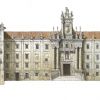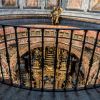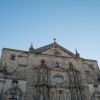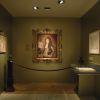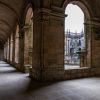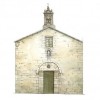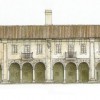- Accede I
- Regístrate I
- carrito
Monasterio e Iglesia de San Martiño Pinario
En la Plaza de la Inmaculada se levanta este monasterio, fundado por un grupo de benedictinos que poco después del descubrimiento de los restos del Apóstol se establecieron en el lugar llamado Pignario, próximo a la capilla de la Corticela (hoy integrada dentro de la Catedral), donde celebraban sus oficios. El mayor desarrollo comienza cuando en 1494 pasa a depender de la congregación benedictina de Valladolid. A partir de aquí alcanzarán la riqueza que les va a permitir sufragar las imponentes obras de la iglesia, que constituye, junto a la Catedral, el más valioso conjunto del barroco gallego. Durante 1991, tras ser acondicionadas las dependencias monásticas y limpiados y restaurados los valiosos retablos, acogió la exposición antológica del arte gallego 'Galicia no tempo'. En el año 2000, en el que Santiago celebró la capitalidad cultural, acogió la exposición 'As Faces de Deus'.
IGLESIA
Los arquitectos que trabajaron en la iglesia fueron el portugués Mateo López, que se encargó de las primeras trazas; el granadino Bartolomé Fernández Lechuga, que construye la magnífica cúpula nervada y organiza el espacio interior consiguiendo una gran majestuosidad; el salmantino Peña y Toro, que se encarga de las obras de contención pues habían cedido los muros, y finalmente, fray Tomás Alonso y fray Gabriel Casas, con distintas aportaciones en la fachada del monasterio, claustros, campanario y dependencias monacales. Sobre la puerta se despliega una vistosa fachada plateresca. Presiden en la parte central, entre la puerta y el óculo, la Virgen, San Bieito y San Bernardo, mientras que en el frontón que corona la portada está San Martiño repartiendo su capa con un pobre. Las torres se levantan sólo hasta la altura de la fachada, debido a la oposición del cabildo catedralicio, temeroso de que la basílica perdiese visibilidad. Para vencer el desnivel del terreno, el benedictino Plácido Camiña construyó la hermosa escalera de acceso a la puerta, sin duda inspirada en la que da acceso a la Catedral desde la fachada del Obradoiro. El templo posee planta de cruz latina con tres naves en el brazo principal y una en el transversal, recorridas por una tribuna. Se emplea la bóveda de cañón en la que se enmascaran los nervios a modo de falsos casetones. Varias capillas comunicadas entre sí, se abren a cada lado del brazo longitudinal. En el interior llama poderosamente la atención el fastuoso retablo mayor de estilo barroco diseñado por F. de Casas y Novoa y ejecutado por Romay. Cerrando los frontispicios del crucero encontramos el Retablo de San Bieito en el norte y el Retablo de la Virgen Inglesa en el sur. Además de los anteriores, también podemos contemplar el Retablo de la capilla del Socorro, el de Santa Escolástica, el del Cristo de la Paciencia y el de Santa Xertrude. Es preciso destacar así mismo, la sillería del coro, realizada en nogal por Mateo de Prado, y que es reconocida como la más importante de las realizadas en Galicia y una de las principales a nivel peninsular.
MONASTERIO
El monasterio es de gran sencillez y frialdad de líneas, sólo interrumpidas por la fachada, a la que se accede por una gran escalinata. La fachada se divide en tres partes con un eje central flanqueado por dos grandes lienzos de cuatro pisos. La torre de cinco cuerpos contribuye a romper la monotonía de la fachada. La portada enmarcada por severas columnas dóricas, acoge a San Bieito, rematando con la estructura añadida por Fernando de Casas en la que está el escudo de España entre vieiras y la figura de San Martiño de Tours. Dentro del monasterio se encuentran el claustro de las oficinas, el más primitivo y el claustro procesional.






















